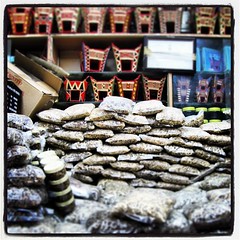- Wild Food, Prices, Diets and Development: Sustainability and Food Security in Urban Cameroon. Local wild foods are better, imported processed foods are cheaper.
- Genetic diversity of teak (Tectona grandis L.F.) from different provenances using microsatellite markers. In Brazil, that is. Lower than expected, therefore future breeding programmes should make more use of the most distinct provenances. But what about bringing some new ones in? Too damn difficult?
- Taxonomic identity of the Iranian diploid Triticum as evidenced by nrDNA ITS. Splitters were right.
- Plant management and biodiversity conservation in Nahuatl homegardens of the Tehuacan Valley, Mexico. Most diverse homegardens located near least diverse natural forest.
- Amenity enhancement and biodiversity conservation in Australian suburbia: moving towards maintaining indigenous plants on private residential land. It would need better laws.
- Food sovereignty: an alternative paradigm for poverty reduction and biodiversity conservation in Latin America. Economic poverty does not necessarily lead to biodiversity loss. But biodiversity loss does often lead to economic poverty.
- Species and hybrid identification of sturgeon caviar: a new molecular approach to detect illegal trade. SNPs can detect the low value, hybrid, aquacultured stuff with great accuracy. In other news, there are sturgeon hybrids.
- Malaysian Species of Plants with Edible Fruits or Seeds and Their Valuation. Over 500, of which about half wild.
- The impact of commodity price and conservation policy scenarios on deforestation and agricultural land use in a frontier area within the Amazon. Weak enforcement leads to more deforestation. And you need fancy maths to figure that out?
- Production and processing of foods as core aspects of nutrition-sensitive agriculture and sustainable diets. It’s no good producing diverse foods if you can’t store and process them.
Nibbles: Banana bionformatics, Banana problems, Dietary diversity indicator, SoD meet, MSSRF & millets, Intercropping tree crops, Ecosystem management, UNEP atlas, Pacific ABS, Seed theft
- Data geeks tuck into bananas.
- Will it help the Filipino smallholder, though?
- Dietary diversity suggested as an indicator of welfare at national level. Wow.
- Seeds of Discovery discovers it has made progress.
- Celebrating a potato breeder. We should do more of that.
- Beer-fueled conservation. Not what you’re thinking.
- Milling minor millets means more money.
- CIRAD breaks down intercropping rubber. And nutmeg?
- Better forest governance by the numbers. How about savannas
- Arab region gets an environmental atlas. Also in Google Earth.
- The Pacific learns about the ITPGRFA. Not for the first time…
- I guess these guys didn’t know about MTAs.
Nibbles: IK, Magi, Yield gap maps, ICRISAT DG, Maize and drought, Phenotyping workshop, Clone epigenetics, Root & tubers, Botanical social networking, Mexican archaeobotany, LOTW
- Intergovernmental Platform on Biodiversity and Ecosystem Services documents examples of how indigenous people’s knowledge conserves biodiversity, including of the agricultural kind.
- The truth about frankincense and myrrh. Talk about traditional knowledge.
- Can global crop production meet future demands? The Story Map.
- What ICRISAT is doing about the above, from the horse’s mouth.
- Progress in Achieving and Delivering Drought Tolerance in Maize — An Update: “Germplasm collections are assuming greater importance if gains from native genes are to be sustained. Efficient and accurate field phenotyping remains essential for genetic progress.”
- Workshop in Field-based High Throughput Phenotyping. Next April, in Arizona, you maize people.
- A clone is a clone is… no wait.
- Root and tuber people already planning their next big shindig, in October 2015. Meanwhile, they’re getting down to work in the Pacific.
- AoB Blog on plant science on Facebook. Also on Facebook.
- Solanum expert Dr Sandy Knapp on the of Global Plants Initiative.
- Archaeological remains of agriculture found in Nuevo Leon are oldest for that Mexican state.
- Legumes (genera) of the world now online, thanks to Kew.
Brainfood: Gaming landuse decisions, Natura 2000, Expressing pears, Medicinal rice, Agroforestry and conservation, Grasslands, Cotton diversity, Ancient cattle, Neolithic Balkans, Indian guar
- Gaming for smallholder participation in the design of more sustainable agricultural landscapes. Board game can be used to facilitate communal decision-making in landuse planning in the buffer zone of a Man and Biosphere Reserve. What’s not to like?
- Mixed effects of long-term conservation investment in Natura 2000 farmland. It has been good for some things, not so good for others. No word on how CWRs have fared.
- Microarray analysis of gene expression patterns during fruit development in European pear (Pyrus communis). They’re different to those of Japanese pear (Pyrus pyrifolia).
- Quantitative and molecular analyses reveal a deep genetic divergence between the ancient medicinal rice (Oryza sativa) Njavara and syntopic traditional cultivars. Njavara is a cryptic variant of traditional Kerala varieties.
- Relationships between Biodiversity and Biological Control in Agroecosystems: Current Status and Future Challenges. Management should aim to suppress pests while maintaining diversity of natural enemy guilds. Easier said than done, I suspect.
- Agroforestry and Biodiversity Conservation in Tropical Landscapes. Between agroforestry cause and conservation effect are a bunch of pesky assumptions. I wonder if gaming would help.
- Livestock grazing and biodiversity in semi-natural grasslands. It can be good. Just one paper in the proceedings of a recent major conference on grasslands.
- Genetic diversity and population structure in the US Upland cotton (Gossypium hirsutum L.). Who needs wild relatives when you have diverse obsolete varieties?
- Morphological and genetic evidence for early Holocene cattle management in northeastern China. Archaeology and DNA suggest parallel domestication of cattle in China.
- Domesticated Animals and Biodiversity: Early Agriculture at the Gates of Europe and Long-term Ecological Consequences. For thousands of years the impact of agriculture in the Balkans was limited.
- Characterization of released and elite genotypes of guar [Cyamopsis tetragonoloba (L.) Taub.] from India proves unrelated to geographical origin. And?
Name the biodiversity product
For sale in Muttrah souk, Muscat, Oman.
